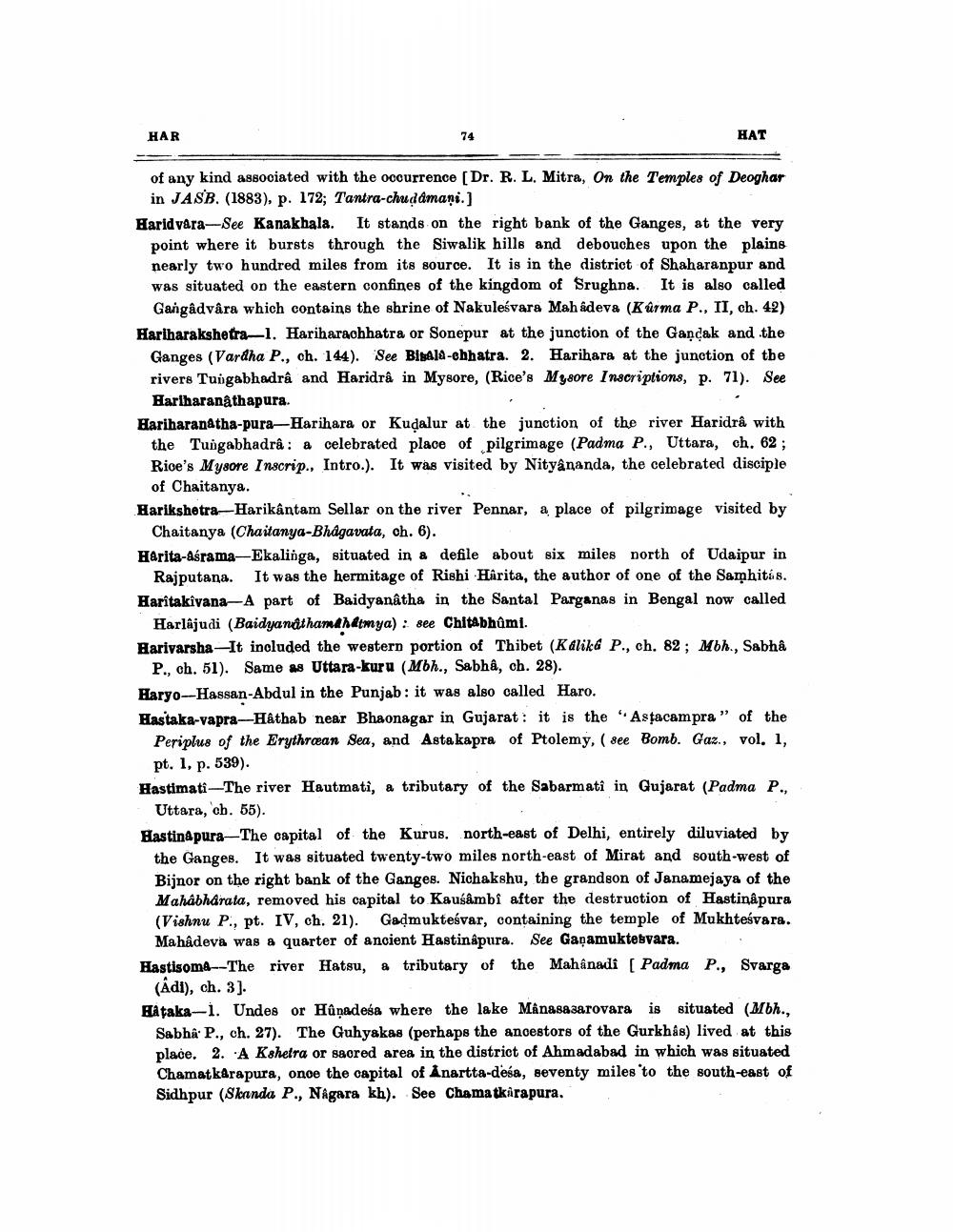________________
HAR
НАТ
of any kind associated with the occurrence [Dr. R. L. Mitra, On the Temples of Deoghar
in JASB. (1883), p. 172; Tantra-chudamani.] Haridvara-See Kanakhala. It stands on the right bank of the Ganges, at the very point where it bursts through the Siwalik hills and debouches upon the plains nearly two hundred miles from its source. It is in the district of Shaharanpur and was situated on the eastern confines of the kingdom of Srughna. It is also called
Gangâdvåra which contains the shrine of Nakuleśvara Mah adeva (Kurma P., II, ch. 42) Hariharakshetra-1. Hariharaobhatra or Sonepur at the junction of the Gancak and the
Ganges (Vardha P., ch. 144). See Binald-chhatra. 2. Harihara at the junction of the rivers Tungabhadrâu and Haridrâ in Mysore, (Rice's Mysore Inscriptions, p. 71). See
Hariharanathapura. Hariharanatha-pura-Harihara or Kudalur at the junction of the river Haridrâ with
the Tungabhadrâ: a celebrated place of pilgrimage (Padma P., Uttara, ch. 62; Rioe's Mysore Inscrip., Intro.). It was visited by Nityananda, the celebrated disciple
of Chaitanya. Harikshetra-Harikântam Sellar on the river Pennar, a place of pilgrimage visited by
Chaitanya (Chaitanya-Bhagavata, ch. 6). Herita-Asrama-Ekalinga, situated in & defile about six miles north of Udaipur in
Rajputana. It was the hermitage of Rishi Harita, the author of one of the Samhitis. Haritakivana-A part of Baidyanatha in the Santal Parganas in Bengal now called
Harlâjudi (Baidyanathamdhatmya) : see Chitabhumi. Harivarsha-It included the western portion of Thibet (Kalika P., ch. 82; Moh., Sabha
P., ch. 51). Same as Uttara-kuru (Mbh., Sabha, ch. 28). Haryo-Hassan Abdul in the Punjab: it was also called Haro. Hastaka-vapra-H&thab near Bhaonagar in Gujarat: it is the 'Astacampra ” of the
Periplus of the Erythraean Sea, and Astakapra of Ptolemy, (see Bomb. Gaz., vol. 1, pt. 1, p. 539). Hastimatî-The river Hautmati, a tributary of the Sabarmati in Gujarat (Padma P.,
Uttara, ch. 55). Hastinapura-The capital of the Kurus. north-east of Delhi, entirely diluviated by the Ganges. It was situated twenty-two miles north-east of Mirat and south-west of Bijnor on the right bank of the Ganges. Nichakshu, the grandson of Janamejaya of the Mahabharata, removed his capital to Kausâmbi after the destruction of Hastinapura (Vishnu P., pt. IV, ch. 21). Gadmukteśvar, containing the temple of Mukhteśvara.
Mahadeva was a quarter of ancient Hastinapura. See Gapamuktesvara. Hastisom--The river Hatsu, a tributary of the Mahanadi ( Padma P., Svarga
(Adi), ch. 3). Hataka-1. Undes or Hûnadesa where the lake Mânasasarovara is situated (Mbh.. Sabha P., ch. 27). The Guhyakas (perhaps the ancestors of the Gurkhas) lived at this place. 2. A Kshetra or sacred area in the district of Ahmadabad in which was situated Chamatkarapura, onoe the capital of Anartta-desa, seventy miles to the south-east of Sidhpur (Skanda P., Nagara kh). See Chamatkarapura.




